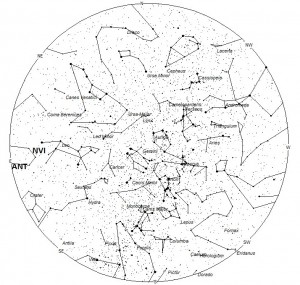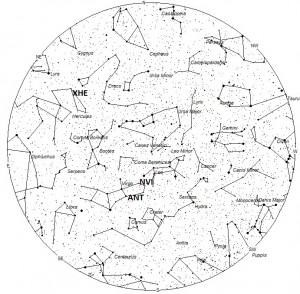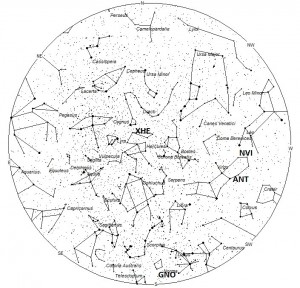
Radiant Positions at 8pm

Radiant Positions at 0100

Radiant Positions at 0600
During this period the moon reaches its new phase on Monday March 11th. At this time the moon is located near the sun and cannot be seen at night. Late in this period the waxing crescent moon will enter the evening sky but will not interfere with meteor observing whatsoever. The estimated total hourly meteor rates for evening observers this week is near two as seen from the northern hemisphere and five as seen from south of the equator. For morning observers the estimated total hourly rates should be near eight from the mid-northern hemisphere and eighteen from the mid-southern hemisphere. The actual rates will also depend on factors such as personal light and motion perception, local weather conditions, alertness and experience in watching meteor activity.
The radiant (the area of the sky where meteors appear to shoot from) positions and rates listed below are exact for Saturday night/Sunday morning March 9/10. These positions do not change greatly day to day so the listed coordinates may be used during this entire period. Most star atlases (available at science stores and planetariums) will provide maps with grid lines of the celestial coordinates so that you may find out exactly where these positions are located in the sky. A planisphere or computer planetarium program is also useful in showing the sky at any time of night on any date of the year. Activity from each radiant is best seen when it is positioned highest in the sky, either due north or south along the meridian, depending on your latitude. It must be remembered that meteor activity is rarely seen at the radiant position. Rather they shoot outwards from the radiant so it is best to center your field of view so that the radiant lies at the edge and not the center. Viewing there will allow you to easily trace the path of each meteor back to the radiant (if it is a shower member) or in another direction if it is a sporadic. Meteor activity is not seen from radiants that are located below the horizon. The positions below are listed in a west to east manner in order of right ascension (celestial longitude). The positions listed first are located further west therefore are accessible earlier in the night while those listed further down the list rise later in the night.
The following showers are expected to be active this week:
On the last day of this period, members of the Northern March Virginids (NVI) should become visible as this shower peaks on the first day of its activity. The radiant is expected to be located at 11:34 (174) +09. This position is located near the Leo-Virgo border between the faint stars Iota Leonis and Nu Virginis. These meteors are best seen near 0100 local daylight time (LDT) when the radiant lies highest above the horizon. Rates would mostly likely be less than one shower member per hour, no matter your location. Since this radiant is located near the celestial equator, this activity can be seen most everywhere. At 22 km/sec. these meteors would have a slow velocity.
The large Anthelion (ANT) radiant is currently centered at 12:08 (182) -02. This position lies in western Virgo, two degrees southwest of the fourth magnitude star Zaniah (Eta Virginis). These meteors may be seen all night long but the radiant is best placed near 0200 LDT when it lies on the meridian and is highest in the sky. Rates at this time should be near two per hour no matter your location. With an entry velocity of 30 km/sec., the average Antihelion meteor would be of slow velocity.
The Gamma Normids (GNO) are active from a radiant located at 15:40 (235) -50. This position lies in western Norma, five degrees northeast of the third magnitude star Zeta Lupi. Due to the southerly declination (celestial latitude) these meteors cannot be seen north of the northern tropical regions. They are best seen from mid-southern latitudes where the radiant lies high in the sky near 0500 local summer time. This shower peaks on March 13 so current hourly rates would be near two per hour as seen from south of the equator and less than one per hour as seen from northern latitudes. At 56km/sec. the Gamma Normids would produce mostly swift meteors.
On Monday March 11, activity from the Xi Herculids (XHE) should become detectable. The peak occurs on Wednesday March 13th when the radiant is located at 17:11 (258) +48. This position is located in northern Hercules, five degrees southwest of the third magnitude star Rastaban (Beta Draconis). These meteors are best seen near during the last dark hour before dawn when the radiant lies highest above the horizon in a dark sky. Rates should be near one shower member per hour as seen from the northern hemisphere. These meteors are not well seen south of the equator as the radiant does not rise very high from points south of the equator. At 37 km/sec. these meteors would have a medium velocity.
As seen from the mid-northern hemisphere (45N) one would expect to see approximately five sporadic meteors per hour during the last hour before dawn as seen from rural observing sites. Evening rates would be near one per hour. As seen from the mid-southern hemisphere (45S), morning rates would be near fourteen per hour as seen from rural observing sites and four per hour during the evening hours. Locations between these two extremes would see activity between the listed figures.
The table below presents a condensed version of the expected activity this week. Rates and positions are exact for Saturday night/Sunday morning .
| SHOWER | DATE OF MAXIMUM ACTIVITY | CELESTIAL POSITION | ENTRY VELOCITY | CULMINATION | HOURLY RATE | CLASS |
| RA (RA in Deg.) DEC | Km/Sec | Local Daylight Time | North-South | |||
| Northern March Virginids (NVI) | Mar 14 | 11:34 (174) +09 | 22 | 01:00 | <1 – <1 | IV |
| Anthelions (ANT) | – | 12:08 (182) -02 | 30 | 02:00 | 2 – 2 | II |
| Gamma Normids (GNO) | Mar 13 | 15:40 (235) -50 | 56 | 06:00 | <1 – 2 | II |
| Xi Herculids (XHE) | Mar 13 | 17:11 (258) +48 | 37 | 07:00 | 1 – <1 | IV |
 American Meteor Society
American Meteor Society
Mar.8, at 4:15 am. Saw fireball about 1/4-1/3 the size of the sun, burning in green red orange, then a tail of yellow and white… It was the largest I have ever seen. I was looking out over the ocean n of Wilmington, NC Then about a 20 sec later another about 1/3 the size of the first came.
Alot of activity in the San Joaquin Valley in the past two weeks. Today, I watched nearly twenty come into our atmosphere. This was facing the East, as the West was covered in clouds.
About 10 pm March 8 in Groveland Township, Mich, saw a large meteor burst into red and orange and end with a broad white tail in the southern sky (moving westerly). Lat. 42.8, Long. 83.5.
Saw a fireball streak the southwest sky about 7:15pm in Columbus, Ohio
Saw a fireball streak the southwest sky about 7:15 pm Columbus, Ohio
Did anyone see an extremely bright light with a wide convoluted contrail accompanied with a loud roaring sound… around 4:00 p.m. Sunday, March 10 in Connecticut ??? It was traveling toward the SW when we first heard the sound. It was very bright even on our clear sunlighted day …. brilliant like a missile launch.
I saw a brilliant green shooting star close to the MA/VT border around 10 PM tonight. 🙂 Not sure if this is the place to report such things but thought I would 🙂
I need to know if any meteor was reported or observed over the northern or north central portion of the state of Oklahoma, on March 12, 2013 at around 8pm. please e-mail me details, direction of travel, duration of fall, color, etc.
Thanks for your help.
R. Noell